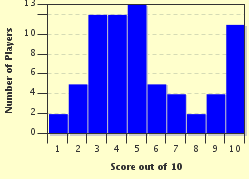Quiz Answer Key and Fun Facts
1. In 1968, two rail companies - the New York Central and Pennsylvania railroad - merged to form Penn Central, then the 6th-largest corporation in the US. The formerly bitter rivals had recognized the trends of the market moving away from rail travel and more towards air and car travel. It was still not enough. How long was it before the new company filed for bankruptcy?
2. Daimler Benz merged with Chrysler in 1998 for $37 billion dollars, creating the company Daimler Chrysler. Nine years later, Daimler Benz cut its losses, selling Chrysler to the Cerberus Capital Management Firm for how much?
3. This toy company was founded in 1945 and became one of the biggest toy-makers in existence. In 1999 it tried to break into the education field by buying the nearly bankrupt 'The Learning Company,' but things didn't work out. A year later, losing $1.5 million per day, 'The Learning Company' was sold and 10% of the toy company's employees were laid off to cut costs. Which toy company?
4. In the year 2005, Sears and K-Mart were purchased by an American businessman and merged to form the Sears Holdings Corporation. Stiff competition from big-box stores like Walmart and Target put the new company into a steady and steep financial decline, and in 2007 the aforementioned businessman was named 'America's Worst CEO' by MarketWatch. Who?
5. America Online (AOL) and Time Warner combined forces in 2001, joining together print and electronic media in what was considered a revolutionary move. In what year did Time Warner finally split with AOL, dropping the internet company at roughly 10% of its former value?
6. The Quaker Oats Company bought into an emerging drinks market at a price tag of $1.7 billion. Twenty-seven months later, Quaker offloaded the drink company for a paltry (in comparison) $300 million - a loss of roughly $1.6 million per day. Which company?
7. In 2005, two communications companies merged and proceded to self-destruct. The companies in question were AT&T and Nextel Communications.
8. Computer software company Novell acquired WordPerfect Corporation back in 1994, but it only took two years for Novell to offload the company to someone else. Stiff competition from rival word processors and incompatibility issues had helped Novell's decision. Who bought WordPerfect from them?
9. Internet company Excite joined forces with @Home_Network for $6.7 billion in 1999, creating Excite@Home. Two years later, the resignation of the second CEO since the merger was announced as the stock had dropped by what percentage over two years?
10. Sometimes mergers fail before they can even get started, due to no fault of the merging companies. In 2001, General Electric (GE) and Honeywell International Inc. were set to merge and become the largest industrial merger in history (to that date) at an estimated value of $40 billion. All it needed was approval from both the European Commission (EC) and the United States Department of Justice. Which governing body nixed the deal, the EC or the US Dept. of Justice?
Source: Author
reedy
This quiz was reviewed by FunTrivia editor
stedman before going online.
Any errors found in FunTrivia content are routinely corrected through our feedback system.

